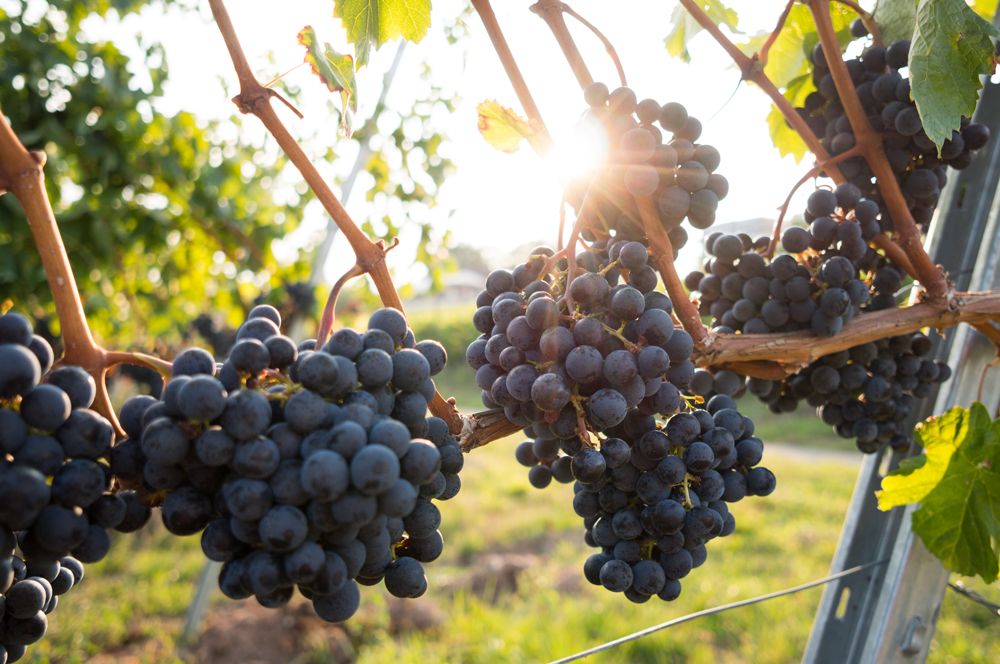
Red vinification
What distinguishes white vinification from red vinification?
What distinguishes white vinification from red vinification?
The main difference lies in maceration, i.e. the contact of the must with the marc (skins and seeds) during fermentation: while in white vinification the solid parts of the grapes are removed immediately after harvesting through soft pressing to prevent the skins from releasing pigments and giving an undesirable colour, in red vinification maceration is essential for the development of colour, structure and longevity. The substances present in the grapes dissolve in the must due to the solvent power of the alcohol, which has a decisive influence on the character of the wine.
Soft pressing is not used for red wine vinification, which would also remove the marc, but destemming is carried out to preserve the marc together with the liquid part. The must obtained is placed in fermenters, usually made of steel, where, thanks to the action of the yeasts, it begins to ferment in contact with the marc.
During the first few days of maceration, mainly anthocyanins, the pigments responsible for the purple and ruby colouring of the grapes, are extracted from the skins, giving the must a very intense colour. As time passes, the skins reabsorb pigments and the colour becomes less bright, but there is a greater extraction of total polyphenols, substances that give the wine a better quality and finesse. The period of time that the liquid part spends in contact with the marc thus becomes a fundamental factor in the evolution of the final product, in the development of its colour, aroma and structure.
Maceration for red wines is on average 10-15 days, although there are exceptions, such as for very light wines to be drunk young, where it is reduced to 4-5 days, or for well-structured wines, where it can be up to 4 weeks.
Fermenters tend to be double-walled with a refrigerant solution flowing through them to keep the must at around 25-30° C, the ideal temperature for extracting a good quantity of polyphenols and at the same time to avoid damaging the yeasts: the latter’s action is inhibited at low temperatures and stops above 37° C. Sometimes the temperature is voluntarily altered for certain periods of time to obtain specific results with certain grape varieties: cold pre-fermentative maceration involves lowering the temperature to facilitate the extraction of aromatic substances and to obtain particularly fine and fragrant wines; in hot post-fermentative maceration, maceration continues even after alcoholic fermentation in a tank maintained at 40° C for a period varying from 24 hours to several days, allowing a greater quantity of polyphenolic compounds to be extracted and, consequently, to obtain more structured and complex wines.
During fermentation, the grape marc is pushed by carbon dioxide to the surface and forms a “grape marc cap” at the top of the fermenter, a compact mass that prevents optimal oxygenation and proper contact with the liquid part. To solve this problem, the must is stirred in two operations: punching down and pumping over. Both not only facilitate the contact of the liquid part with the marc for a better extraction of polyphenols and oxygenate the must – which stimulates yeast activity – but also lower the temperature and prevent the marc from being in too much contact with the air, drying out or being attacked by acetic bacteria.
Punching down, which used to be carried out by hand using sticks, now consists of applying mechanical pressure with a piston to the cap of the grape marc, causing it to break and dissolve into liquid. An alternative to this process is to carry out submerged cap fermentation, i.e. using a perforated diaphragm inserted into the fermenter to hold the marc in the liquid and prevent it from returning to the surface.
In pumping over, on the other hand, the must is run through an external tube from the bottom of the fermenter to the surface where it is sprayed onto the grape marc cap to break it up. In the case of wines destined for lengthy ageing, délestage is also used during maceration, an operation that always serves to oxygenate the must and to remix the sugars, yeasts and polyphenols: in this case, halfway through maceration or towards the end, all the liquid is extracted from the fermenter and then reinserted from above or below to break up the cap.
At the end of the fermentation, which is called tumultuous due to the bubbling of carbon dioxide, racking takes place, which involves separating the solid parts (skins, lees, salts, dead yeast cells) from the liquid parts. The wine drawn from the bottom of the fermenter, free of solid particles, is called new wine or first pressing. A further liquid part is added to this, obtained by pressing or squeezing the marc. This is increasingly done using horizontal membrane presses that operate gently, preventing the grape seeds from releasing astringent and bitter tannins into the wine through excessive crushing.
The spent marc is then sent to distilleries for the production of Grappa while the wine, before being bottled, undergoes stabilisation treatments and a period of maturation in steel or wood, which can be longer or shorter depending on the product to be obtained.



